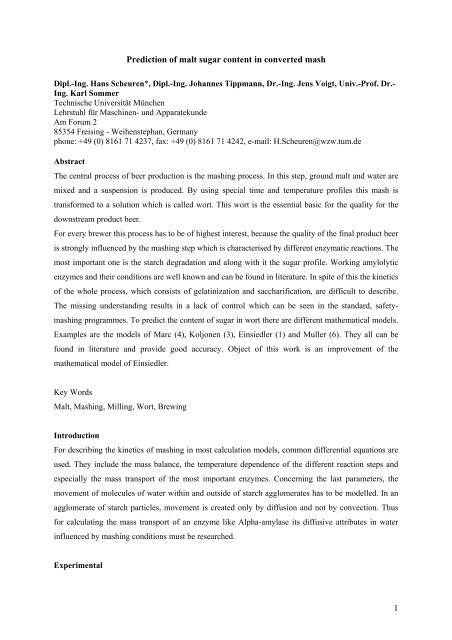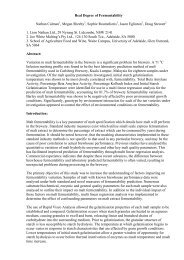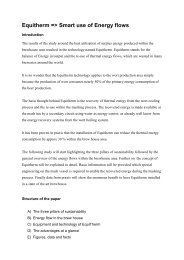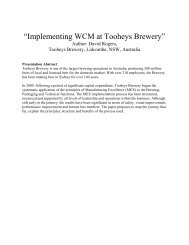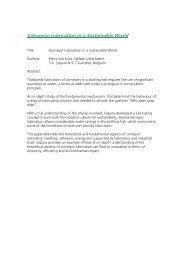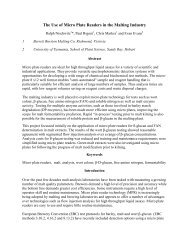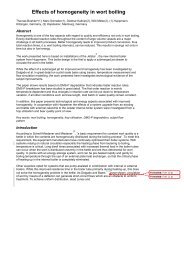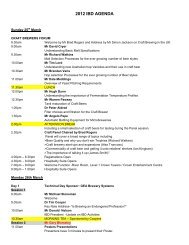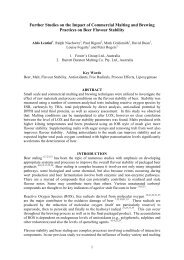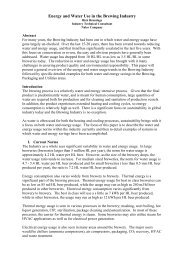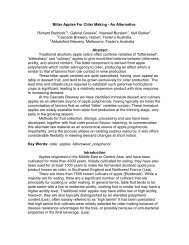Prediction of Malt Sugar Content in Converted Mash
Prediction of Malt Sugar Content in Converted Mash
Prediction of Malt Sugar Content in Converted Mash
You also want an ePaper? Increase the reach of your titles
YUMPU automatically turns print PDFs into web optimized ePapers that Google loves.
<strong>Prediction</strong> <strong>of</strong> malt sugar content <strong>in</strong> converted mashDipl.-Ing. Hans Scheuren*, Dipl.-Ing. Johannes Tippmann, Dr.-Ing. Jens Voigt, Univ.-Pr<strong>of</strong>. Dr.-Ing. Karl SommerTechnische Universität MünchenLehrstuhl für Masch<strong>in</strong>en- und ApparatekundeAm Forum 285354 Freis<strong>in</strong>g - Weihenstephan, Germanyphone: +49 (0) 8161 71 4237, fax: +49 (0) 8161 71 4242, e-mail: H.Scheuren@wzw.tum.deAbstractThe central process <strong>of</strong> beer production is the mash<strong>in</strong>g process. In this step, ground malt and water aremixed and a suspension is produced. By us<strong>in</strong>g special time and temperature pr<strong>of</strong>iles this mash istransformed to a solution which is called wort. This wort is the essential basic for the quality for thedownstream product beer.For every brewer this process has to be <strong>of</strong> highest <strong>in</strong>terest, because the quality <strong>of</strong> the f<strong>in</strong>al product beeris strongly <strong>in</strong>fluenced by the mash<strong>in</strong>g step which is characterised by different enzymatic reactions. Themost important one is the starch degradation and along with it the sugar pr<strong>of</strong>ile. Work<strong>in</strong>g amylolyticenzymes and their conditions are well known and can be found <strong>in</strong> literature. In spite <strong>of</strong> this the k<strong>in</strong>etics<strong>of</strong> the whole process, which consists <strong>of</strong> gelat<strong>in</strong>ization and saccharification, are difficult to describe.The miss<strong>in</strong>g understand<strong>in</strong>g results <strong>in</strong> a lack <strong>of</strong> control which can be seen <strong>in</strong> the standard, safetymash<strong>in</strong>gprogrammes. To predict the content <strong>of</strong> sugar <strong>in</strong> wort there are different mathematical models.Examples are the models <strong>of</strong> Marc (4), Koljonen (3), E<strong>in</strong>siedler (1) and Muller (6). They all can befound <strong>in</strong> literature and provide good accuracy. Object <strong>of</strong> this work is an improvement <strong>of</strong> themathematical model <strong>of</strong> E<strong>in</strong>siedler.Key Words<strong>Malt</strong>, <strong>Mash</strong><strong>in</strong>g, Mill<strong>in</strong>g, Wort, Brew<strong>in</strong>gIntroductionFor describ<strong>in</strong>g the k<strong>in</strong>etics <strong>of</strong> mash<strong>in</strong>g <strong>in</strong> most calculation models, common differential equations areused. They <strong>in</strong>clude the mass balance, the temperature dependence <strong>of</strong> the different reaction steps andespecially the mass transport <strong>of</strong> the most important enzymes. Concern<strong>in</strong>g the last parameters, themovement <strong>of</strong> molecules <strong>of</strong> water with<strong>in</strong> and outside <strong>of</strong> starch agglomerates has to be modelled. In anagglomerate <strong>of</strong> starch particles, movement is created only by diffusion and not by convection. Thusfor calculat<strong>in</strong>g the mass transport <strong>of</strong> an enzyme like Alpha-amylase its diffusive attributes <strong>in</strong> water<strong>in</strong>fluenced by mash<strong>in</strong>g conditions must be researched.Experimental1
The diffusion <strong>of</strong> a molecule is described by its diffusion coefficient. This parameter is characteristicfor a molecule or a substance <strong>in</strong> a surround<strong>in</strong>g medium and is <strong>in</strong>fluenced by factors like the size <strong>of</strong> themolecule. Another important variable consists <strong>in</strong> the temperature dependence <strong>of</strong> diffusion. In the case<strong>of</strong> mash<strong>in</strong>g, vary<strong>in</strong>g temperatures dur<strong>in</strong>g the <strong>in</strong>dividual mash<strong>in</strong>g programmes have to be considered.In the work <strong>of</strong> E<strong>in</strong>siedler the mass transport caused by diffusion is affected by an additional parameter.<strong>Mash</strong>es brewed by differently milled malt result <strong>in</strong> vary<strong>in</strong>g wort qualities (1,5). That means thatchanges <strong>in</strong> the particle size distribution <strong>in</strong>fluence the mash<strong>in</strong>g process. Vary<strong>in</strong>g sizes <strong>of</strong> the starchgranules caused by natural fluctuations <strong>of</strong> the resource malt and its splitt<strong>in</strong>g or agglomeration causedby malt<strong>in</strong>g have an additional <strong>in</strong>fluence on the mass transport <strong>of</strong> water <strong>in</strong> starch particles and theenzymes <strong>in</strong>side.As a consequence the parameterisation <strong>of</strong> a mathematical model which is only adapted to mashes isstrongly <strong>in</strong>fluenced by the mill<strong>in</strong>g, malt<strong>in</strong>g and barley conditions. The result<strong>in</strong>g diffusive properties <strong>of</strong>Alpha-amylase, which can be calculated by the mass transport, are strongly <strong>in</strong>consistent.Therefore a new version <strong>of</strong> a calculation model by E<strong>in</strong>siedler is presented, which is matched to purecomponent systems, just consist<strong>in</strong>g <strong>of</strong> water, barley flour and Alpha-amylase. Furthermore the flour isagglomerated by the method “Concentrated Powder Form” (CPF) (2) to get different particle sizedistributions simulat<strong>in</strong>g vary<strong>in</strong>g malt qualities and mill<strong>in</strong>g conditions. This procedure means thepossibility to detect the relation between mass transport, diffusion and particle size distribution.One flour is agglomerated with 8%, another one is agglomerated with 15% water. The orig<strong>in</strong>al and theagglomerated ones were dried for 24 hours at 65°C to the same low moisture <strong>of</strong> 1-3%. The follow<strong>in</strong>gfigure shows particles <strong>of</strong> flour which were agglomerated with 8 and 15 % water. The structures <strong>of</strong> theparticles which are caused by the small starch granules can be seen <strong>in</strong> these pictures.300 µm80 µmFigure 1: Agglomerated flour (15% water)Figure 2: Agglomerated flour (8% water)2
By us<strong>in</strong>g an isothermal mash<strong>in</strong>g programme with<strong>in</strong> a typical temperature range (55-75°C) the k<strong>in</strong>etics<strong>of</strong> the creation <strong>of</strong> extract and sugars were <strong>in</strong>vestigated, the viscosity and variances <strong>in</strong> the viscosityconcern<strong>in</strong>g changes <strong>in</strong> the particle size distribution were also determ<strong>in</strong>ed. Tak<strong>in</strong>g all this <strong>in</strong>formation<strong>in</strong>to account the mass transport <strong>of</strong> the enzyme Alpha-amylase can be described and calculated forvary<strong>in</strong>g mash<strong>in</strong>g conditions.The model used is based on the work <strong>of</strong> E<strong>in</strong>siedler which is mathematically based on the work <strong>of</strong>Kettunen et al. To describe the whole process <strong>of</strong> starch degradation and <strong>of</strong> saccharification 16differential equations are <strong>in</strong>troduced.The activity <strong>of</strong> the Alpha-amylase is expressed by four equations. Two equations conta<strong>in</strong> variablesconcern<strong>in</strong>g the concentration <strong>of</strong> enzyme <strong>in</strong> grist and water, the ratio grist to water volume and thediffusive constant. This parameter is calculated with a third equation which describes the temperaturedependency <strong>of</strong> the diffusion. A reaction constant for the enzyme <strong>in</strong>activation is calculated with thefourth equation by Arrhenius law. Therefore the activation energy has to be <strong>in</strong>vestigated.The activity <strong>of</strong> the Beta-Amylase is expressed by three equations. Two equations are similar to Alphaamylase.The diffusion is seen as <strong>in</strong>dependent from temperature and therefore it is a constant. Thethird equation describes the <strong>in</strong>activation <strong>of</strong> the Beta-Amylase.These formulae are components <strong>of</strong> the follow<strong>in</strong>g ones which <strong>in</strong>clude the conversion <strong>of</strong> starch <strong>in</strong> sugar(e.g. glucose, maltose, maltotriose) and dextr<strong>in</strong>es. Important variables are the concentration <strong>of</strong>enzymes, <strong>of</strong> starch and their different factors describ<strong>in</strong>g the reaction velocity and quality.Figure 3 shows the processes <strong>in</strong>cluded <strong>in</strong> the model.Figure 3: Schematic representation <strong>of</strong> mash<strong>in</strong>g processThe diffusion <strong>of</strong> Alpha-amylase is marked by r<strong>in</strong>gs. The quality <strong>of</strong> the saccharification is dependent onthe cleavage <strong>of</strong> starch and its degradation by Alpha-amylase. It is obvious that the mass transport andthe reaction <strong>of</strong> this enzyme are the basic steps for the subsequent enzymatic reactions.More <strong>in</strong>formation concern<strong>in</strong>g the model can be found <strong>in</strong> literature (2, 3).3
The aim <strong>of</strong> this work is to research the <strong>in</strong>fluence <strong>of</strong> the particle size distribution on the mass transport<strong>of</strong> Alpha-amylase and the mash<strong>in</strong>g success. The first result can be seen <strong>in</strong> the follow<strong>in</strong>g figures.Particle size distribution at the beg<strong>in</strong>n<strong>in</strong>g <strong>of</strong> mash<strong>in</strong>g (75°C)1particle size distribution [-]0,90,80,70,60,50,40,3flourflour agglomerated0,20,100 50 100 150 200 250 300 350 400 450 500particle size [µm]Figure 4: comparison <strong>of</strong> the particle size distribution <strong>of</strong> flour and flour agglomerated (15%) at thebeg<strong>in</strong>n<strong>in</strong>g <strong>of</strong> mash<strong>in</strong>gParticle size distribution at the end <strong>of</strong> mash<strong>in</strong>g (75°C)1,0particle size distribution [-]0,90,80,70,60,50,40,3flourflour agglomerated0,20,10,00 50 100 150 200 250 300 350 400 450 500particle size [µm]Figure 5: comparison <strong>of</strong> the particle size distribution <strong>of</strong> flour and flour agglomerated (15%) at the end <strong>of</strong>mash<strong>in</strong>g4
Figure 4 conta<strong>in</strong>s the particle size distribution <strong>of</strong> flour and flour agglomerated by CPF with 15% waterat the beg<strong>in</strong>n<strong>in</strong>g <strong>of</strong> the mash<strong>in</strong>g process. Figure 5 describes the particle size distribution <strong>of</strong> flour andagglomerated flour at the end <strong>of</strong> the experiments. Both experiments are performed three times asisothermal mashes at a temperature <strong>of</strong> 75°C.The development <strong>in</strong> the particle size distribution is obvious. Furthermore the differences between bothflours are obvious too. The values <strong>of</strong> the different x 50 - factors at the beg<strong>in</strong>n<strong>in</strong>g and at the end <strong>of</strong> themash<strong>in</strong>g experiment confirm this comparison.x 50 (flour) x 50 (flour agglomerated)start <strong>of</strong> mash (40,5 ± 0,72) µm (55,01 ± 7,04) µmend <strong>of</strong> mash (85,42 ± 6,70) µm (205,26 ± 43,14) µmTable I: Comparison <strong>of</strong> x 50 -valuesThese results are used to calculate the mass transport <strong>of</strong> Alpha-amylase consider<strong>in</strong>g the differentdiffusion constants for 55, 65 and 75°C and the particle size distribution. The mathematical modelused is parameterised with these values. Consecutively one result concern<strong>in</strong>g the creation <strong>of</strong> extract ispresented. Figure 5 conta<strong>in</strong>s an experiment <strong>in</strong> laboratory scale concern<strong>in</strong>g malt milled with mill gap <strong>of</strong>0.2 mm.Figure 5: Comparison <strong>of</strong> prediction and experiment with malt milled (gap 0.2 mm)The calculation curve is conform<strong>in</strong>g to the experimental value and its confidence belt. The diagramshows the quality <strong>of</strong> the prediction <strong>of</strong> the extract at the end <strong>of</strong> the mash<strong>in</strong>g process.5
DiscussionThe aim <strong>of</strong> this work is to show the possibility <strong>of</strong> the prediction <strong>of</strong> the content <strong>of</strong> sugars and dextr<strong>in</strong>esat the end <strong>of</strong> the mash<strong>in</strong>g process us<strong>in</strong>g a calculation method. Therefore a new version <strong>of</strong> the model byE<strong>in</strong>siedler is presented, which is matched to pure component systems and adapted to mashes. By thismethod the <strong>in</strong>fluence <strong>of</strong> the particle size distribution on the starch particles can be described.The new parameterised model is tested on a laboratory scale and provides good predictability. Toexpand and to optimise the predicted results it is planned to research the k<strong>in</strong>etics <strong>of</strong> the mass transport<strong>of</strong> the Beta-amylase. Furthermore the k<strong>in</strong>etics <strong>of</strong> decomposition <strong>of</strong> Beta-glucan will be researched.These results will help to improve the accuracy and the adaptability. By this method the practical use<strong>of</strong> the described prediction method will be <strong>in</strong>creased and the model could become a possibility toimprove the standard mash<strong>in</strong>g programmes.AcknowledgementsThe Authors would like to thank Novozymes, Krogshoejvej, Denmark for their friendly support.References(1) E<strong>in</strong>siedler, F., Schwill-Miedaner, A., Sommer, K., Hämälä<strong>in</strong>en, J Reaction k<strong>in</strong>etic studies onthe modell<strong>in</strong>g <strong>of</strong> starch hydrolyses dur<strong>in</strong>g mash<strong>in</strong>g. Brauwelt, 1997, 137, 1598-1603.(2) Grüner, S., Otto, F., Weidenreich, B., Chemie Ingenieur Technik, 75, 2003, 690-693.(3) Koljonen, T., Hämälä<strong>in</strong>en, J. Sjöholm K., Pietilä, K., A Model fort he <strong>Prediction</strong> <strong>of</strong>Fermentable <strong>Sugar</strong> Concentrations Dur<strong>in</strong>g <strong>Mash</strong><strong>in</strong>g. J Food Eng<strong>in</strong>eer<strong>in</strong>g, 1995, 29,185-200.(4) Marc, A., Engasser, J.M., Moll, M., A K<strong>in</strong>etic Model <strong>of</strong> Starch Hydrolysis by α- and β-Amylase dur<strong>in</strong>g <strong>Mash</strong><strong>in</strong>g. Biotechnol Bioeng, 1983, 25, 481-496.(5) Mousia, Z., Balk<strong>in</strong>, R.C., Pandiella, S.S., Webb, C., Te effect <strong>of</strong> mill<strong>in</strong>g parameters on starchhydrolysis <strong>of</strong> milled malt <strong>in</strong> the brew<strong>in</strong>g process, Process Biochemistry, 39, 2004, 2213-2219.(6) Muller, R. A mathematical model <strong>of</strong> the formation <strong>of</strong> fermentable sugars from starchhydolysis dur<strong>in</strong>g high-temperature mash<strong>in</strong>g, Enzyme and Microbial Technology, 2000, 27,337-344.6


